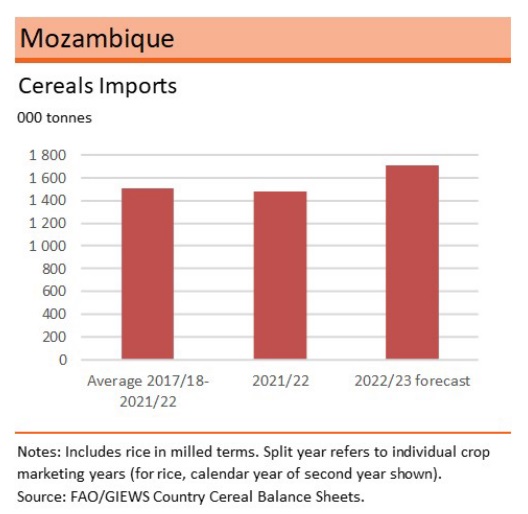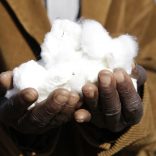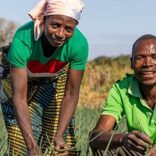Mozambique: Agriculture sector needs to think long-term - analysts
GIEWS Country Brief: Mozambique 16-August-2022 | FAO

Source: FAO/GIEWS, FEWS NET, USDA
- GIEWS global information and early warning system on food and agriculture
Food Security Snapshot
- Cereal production in 2022 estimated at below-average level, as adverse weather conditions and impact of conflicts curtail crop yields and cause localised crop losses
- Cereal import requirements in 2022/23 forecast to rise to above-average level
- Elevated global prices of energy and foods push up domestic prices
- Worsening conflict, high prices and localized shortfalls in crop production foreseen to amplify humanitarian needs in 2022/23
Cereal production forecast below five‑year average in 2022
Harvesting of the main 2022 season cereal crops was completed in June and total cereal production, including the minor secondary season crops to be harvested in the third-quarter of the year, is forecast at a below‑average level of 2.6 million tonnes in 2022, pending official estimates.
At the subnational level and primarily reflecting regional variations in weather conditions, cereal harvests differed across the country. In southern provinces, which account for a small proportion of the total national cereal output, harvests are estimated at well below‑average levels mainly reflecting the impact of substantial rainfall shortages between February and March 2022. In the main cereal producing central provinces, namely Manica and Sofala, southern parts experienced below average rainfall amounts and an irregular distribution, resulting in crop failure and low yields. By contrast, cereal crops in northern areas of these provinces fared better, owing to broadly conducive weather conditions. Consequently, total harvests in central provinces are estimated to be close to the five‑year averages. In the northern provinces, the temporal distribution of rains and total cumulative amounts were generally beneficial for crops and cereal outturns in these provinces, which contribute about one‑quarter to the national cereal outturn, are estimated at near‑average levels in 2022.
The impact of several tropical storms, as well as Cyclone Gombe that made landfall in March 2022, also caused crop damage and losses in the central and northern provinces, contributing to the low output in 2022; cumulatively more than 220 000 hectares of cropland were affected by the extreme weather events. Cyclone Gombe alone resulted in an estimated 20 500 hectares of cropland in Zambezia and Nampula provinces (less than 5 percent of the area planted with cereals) being inundated, according to FAO’s geospatial analysis . In addition to crop and livestock losses, the cyclone caused losses of fishing gear, destruction of boats and damage to agricultural infrastructure, including irrigation systems, which is likely to impact crop production during the 2022 secondary season. Persisting insecurity in Cabo Delgado, which continued to severely impede farmers’ ability to access to agricultural inputs, including land, was another factor that limited crop production in the northern provinces in 2022.
Cereal imports forecast to increase in 2022/23
The cereal import requirement is forecast at 1.7 million tonnes in the 2022/23 marketing year (April/March), 13 percent more than the previous five‑year average and the imported quantity in 2021/22.
Import requirements of rice are estimated at an above‑average level of 780 000 tonnes, reflecting the downturn in production and therefore a moderately larger domestic supply gap. Maize imports, for both food and feed use, are forecast at 275 000 tonnes, slightly above the five‑year average, with most imports sourced from neighbouring South Africa.
By contrast, imports of wheat, which is not grown in the country, are forecast at an average level of 650 000 tonnes, as a drawdown in stocks is expected to limit import growth amid high global prices. In the preceding three marketing years, wheat supplies from the Russian Federation and Ukraine accounted for an average of 38 percent of the total wheat imports. Mozambique may therefore face supply constraints as it seeks to secure supplies from alternative origins given the supply disruptions caused by the war in Ukraine and the subsequent hike in global prices.
Food prices rise, underpinned by elevated global prices
The annual food inflation rate was estimated at 10 percent in June 2022, up from 8 percent in January 2022. Inflation growth has been underpinned by rising prices of food and transportation, owing to the elevated global prices. However, unlike several neighbouring countries, the value of the national currency (metical) against the US dollar has remained stable in 2022, helping to curb imported inflationary pressure, while government price subsidies for fuel and wheat have also partly cushioned the effects of higher import costs.
Number of food insecure people seen to rise in 2022/23
The IPC acute food insecurity forecast for the peak lean period between December 2022 and March 2023 is not yet available. However, the number of people in need of food assistance is expected to rise above the 1.86 million estimated in 2021/22 because of three key factors. Firstly, higher year‑on‑year prices of food and fuel are reducing households’ purchasing power, worsening their economic access to food, particularly for low-income households. Secondly, the impact of extreme weather events on agricultural production in central and southern provinces in 2022 is likely to mean that farming households in the affected areas have both low food supplies from own production and curtailed income-earning opportunities from crop sales, impinging on their food availability and economic access to food. Thirdly, there has been an increase in attacks by non‑state armed groups in the northern province of Cabo Delgado in 2022, and this has led to a rise in the number of internally displaced persons (IDPs). As of June 2022, 946 508 people had been displaced in northern areas affected by conflict, up by more than 30 percent compared to the previous year; IDPs are facing the highest levels of acute food insecurity. The increased number of insecurity incidents has also disrupted the delivery of humanitarian assistance.
Disclaimer: The designations employed and the presentation of material in this information product do not imply the expression of any opinion whatsoever on the part of FAO concerning the legal status of any country, territory, city or area or of its authorities, or concerning the delimitation of its frontiers or boundaries.














Leave a Reply
Be the First to Comment!
You must be logged in to post a comment.
You must be logged in to post a comment.